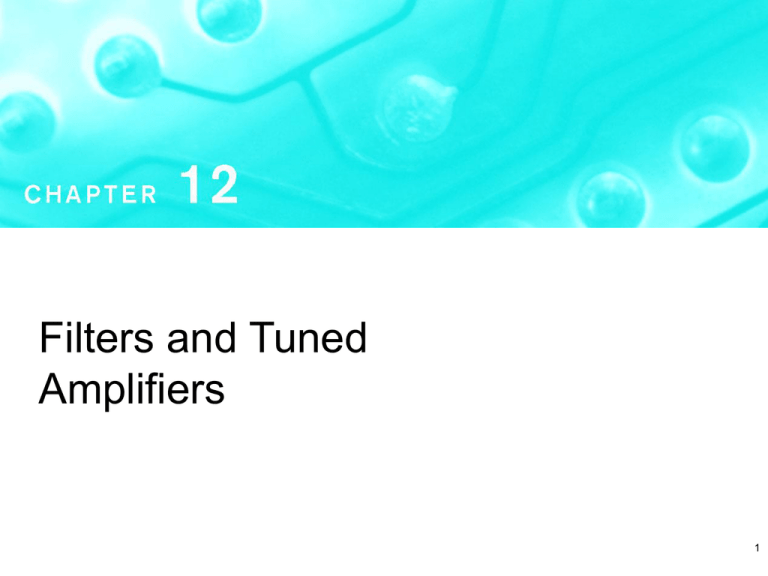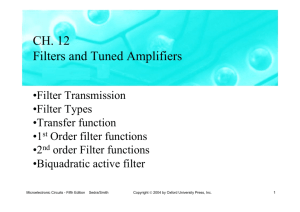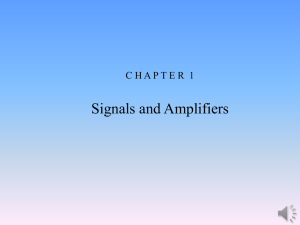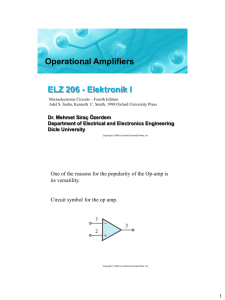sedra42021_ch12ActiveFiltersEdited
advertisement

Filters and Tuned Amplifiers 1 Figure 12.1 The filters studied in this chapter are linear circuits represented by the general two-port network shown. The filter transfer function T(s) Vo(s)/Vi(s). Microelectronic Circuits - Fifth Edition Sedra/Smith Copyright 2004 by Oxford University Press, Inc. 2 Figure 12.2 Ideal transmission characteristics of the four major filter types: (a) low-pass (LP), (b) high-pass (HP), (c) bandpass (BP), and (d) bandstop (BS). Microelectronic Circuits - Fifth Edition Sedra/Smith Copyright 2004 by Oxford University Press, Inc. 3 12.2 The Filter Transfer Function s z1 s z2 s z M T s aM s p1 s p2 s pN T s aM T s aM s s s 1 1 1 z1 z2 zM z1 z2 zM p1 p2 pN s s s 1 1 1 p1 p2 pN 1 M z1 z2 zM p1 p2 pN 1 N Microelectronic Circuits - Fifth Edition Sedra/Smith 1 1 s s s 1 1 z1 z2 zM s s s 1 1 p1 p2 pN Copyright 2004 by Oxford University Press, Inc. 4 12.2 The Filter Transfer Function T s aM 1 M z1 z2 zM p1 p2 pN 1 N 1 1 s s s 1 1 z1 z2 zM s s s 1 1 p1 p2 pN If we include zeroes at infinity, then M = N: T s aM Microelectronic Circuits - Fifth Edition z1 z2 z N p1 p2 pN Sedra/Smith 1 1 s s s 1 1 z1 z2 zN s s s 1 1 p1 p2 pN Copyright 2004 by Oxford University Press, Inc. 5 5th Order Low Pass Filter Figure 12.3 Specification of the transmission characteristics of a low-pass filter. The magnitude response of a filter that just meets specifications is also shown. Figure 12.5 Pole–zero pattern for the low-pass filter whose transmission is sketched in Fig. 12.3. This is a fifth-order filter (N = 5). Microelectronic Circuits - Fifth Edition Sedra/Smith Copyright 2004 by Oxford University Press, Inc. 6 6th Order Band Pass Filter: Figure 12.4 Transmission specifications for a bandpass filter. The magnitude response of a filter that just meets specifications is also shown. Note that this particular filter has a monotonically decreasing transmission in the passband on both sides of the peak frequency. Figure 12.6 Pole–zero pattern for the band-pass filter whose transmission function is shown in Fig. 12.4. This is a sixth-order filter (N = 6). Microelectronic Circuits - Fifth Edition Sedra/Smith Copyright 2004 by Oxford University Press, Inc. 7 All-pole filter (no finite zeroes): Figure 12.7 (a) Transmission characteristics of a fifth-order low-pass filter having all transmission zeros at infinity. (b) Pole–zero pattern for the filter in (a). Microelectronic Circuits - Fifth Edition Sedra/Smith Copyright 2004 by Oxford University Press, Inc. 8 12.3 Butterworth Filter: T j 1 1 2 P 2N At P T j P T j P T j max Amax 1 1 2 T j P 1 1 2 1 T j max 20 log10 20 log10 T j P 1 2 10 log 10 1 2 Figure 12.8 The magnitude response of a Butterworth filter. Microelectronic Circuits - Fifth Edition Sedra/Smith Copyright 2004 by Oxford University Press, Inc. 9 12.3 Butterworth Filter: Figure 12.9 Magnitude response for Butterworth filters of various order with e = 1. Note that as the order increases, the response approaches the ideal brick-wall type of transmission. Microelectronic Circuits - Fifth Edition Sedra/Smith Copyright 2004 by Oxford University Press, Inc. 10 12.3.2 The Chebyshev Filter 1 2 2 1 1 cos N cos P T j 1 1 2 cosh 2 N cosh 1 P At P T j P T j P T j max Amax for P 1 1 2 T j P 1 1 2 1 T j max 20 log10 20 log10 T j P Microelectronic Circuits - Fifth Edition for P Sedra/Smith 1 2 10 log10 1 2 Copyright 2004 by Oxford University Press, Inc. 11 Figure 12.12 Sketches of the transmission characteristics of representative (a) even-order and (b) odd-order Chebyshev filters. Microelectronic Circuits - Fifth Edition Sedra/Smith Copyright 2004 by Oxford University Press, Inc. 12 12.4.1 First-order Filters T s Microelectronic Circuits - Fifth Edition Sedra/Smith a1 s a0 s 0 Copyright 2004 by Oxford University Press, Inc. 13 Figure 12.13 First-order filters. Microelectronic Circuits - Fifth Edition Sedra/Smith Copyright 2004 by Oxford University Press, Inc. 14 Figure 12.14 First-order all-pass filter. Microelectronic Circuits - Fifth Edition Sedra/Smith Copyright 2004 by Oxford University Press, Inc. 15 12.4.2 Second-Order Filters a2 s 2 a1 s a0 T s 2 s 0 Q s 02 p1 , p2 0 2Q j 0 1 1 4 Q 2 For filters, usually Q 0.5 complex-conjugate poles Figure 12.15 Definition of the parameters 0 and Q of a pair of complex-conjugate poles. Microelectronic Circuits - Fifth Edition Sedra/Smith Copyright 2004 by Oxford University Press, Inc. 16 Figure 12.16 Second-order filtering functions. Microelectronic Circuits - Fifth Edition Sedra/Smith Copyright 2004 by Oxford University Press, Inc. 17 Figure 12.16 (Continued) Microelectronic Circuits - Fifth Edition Sedra/Smith Copyright 2004 by Oxford University Press, Inc. 18 Figure 12.16 (Continued) Microelectronic Circuits - Fifth Edition Sedra/Smith Copyright 2004 by Oxford University Press, Inc. 19 12.5 Second-Order LCR Filters a2 s 2 a1 s a0 T s 2 s 0 Q s 02 o 1 LC 02 1 LC Q o R C o Q 1 RC 1 C RC R L LC Figure 12.17 (a) The second-order parallel LCR resonator. (b, c) Two ways of exciting the resonator of (a) without changing its natural structure: resonator poles are those poles of Vo/I and Vo/Vi. Microelectronic Circuits - Fifth Edition Sedra/Smith Copyright 2004 by Oxford University Press, Inc. 20 Figure 12.18 Realization of various second-order filter functions using the LCR resonator of Fig. 12.17(b): (a) general structure, (b) LP, (c) HP, (d) BP, (e) notch at 0, (f) general notch, (g) LPN (n 0), (h) LPN as s , (i) HPN (n 0). Microelectronic Circuits - Fifth Edition Sedra/Smith Copyright 2004 by Oxford University Press, Inc. 21 Figure 12.19 Realization of the second-order all-pass transfer function using a voltage divider and an LCR resonator. Microelectronic Circuits - Fifth Edition Sedra/Smith Copyright 2004 by Oxford University Press, Inc. 22 12.6.1 The Antoniou InductanceSimulation Circuit L C4 R1 R3 R5 R2 Figure 12.20 (a) The Antoniou inductance-simulation circuit. (b) Analysis of the circuit assuming ideal op amps. The order of the analysis steps is indicated by the circled numbers. Microelectronic Circuits - Fifth Edition Sedra/Smith Copyright 2004 by Oxford University Press, Inc. 23 Figure 12.21 (a) An LCR resonator. (b) An op amp–RC resonator obtained by replacing the inductor L in the LCR resonator of (a) with a simulated inductance realized by the Antoniou circuit of Fig. 12.20(a). (c) Implementation of the buffer amplifier K. Microelectronic Circuits - Fifth Edition Sedra/Smith Copyright 2004 by Oxford University Press, Inc. 24 Figure 12.22 Realizations for the various second-order filter functions using the op amp–RC resonator of Fig. 12.21(b): (a) LP, (b) HP, (c) BP, Microelectronic Circuits - Fifth Edition Sedra/Smith Copyright 2004 by Oxford University Press, Inc. 25 Figure 12.22 (Continued) (d) notch at 0, (e) LPN, n 0, (f) HPN, n 0, and (g) all pass. The circuits are based on the LCR circuits in Fig. 12.18. Design equations are given in Table 12.1. Microelectronic Circuits - Fifth Edition Sedra/Smith Copyright 2004 by Oxford University Press, Inc. 26 Second-Order Active Filters Based on the Two-integrator-loop Biquad Microelectronic Circuits - Fifth Edition Sedra/Smith Copyright 2004 by Oxford University Press, Inc. 27 Second-Order Active Filters Based on the Two-integrator-loop Biquad Kerwin-Huelsman-Newcomb biquad Microelectronic Circuits - Fifth Edition Sedra/Smith Copyright 2004 by Oxford University Press, Inc. 28 Second-Order Active Filters Based on the Two-integrator-loop Biquad Figure 12.25 (a) Derivation of an alternative two-integrator-loop biquad in which all op amps are used in a single-ended fashion. (b) The resulting circuit, known as the Tow–Thomas biquad. Microelectronic Circuits - Fifth Edition Sedra/Smith Copyright 2004 by Oxford University Press, Inc. 29 12.10 Switched Capacitor Filters 12.10.1 The Basic Principle: A capacitor switched between two circuit nodes at a sufficiently high rate is equivalent to a resistor connecting these two nodes. Microelectronic Circuits - Fifth Edition Sedra/Smith Copyright 2004 by Oxford University Press, Inc. 30 fc 1 Tc f sig max qC1 C1 vi qC1 qC 2 C1 vi v T Req i c Tc iav C1 Tc C2 integrator time constant = Req C2 C2 Tc C1 C1 iav Figure 12.35 Basic principle of the switched-capacitor filter technique. (a) Active-RC integrator. (b) Switched-capacitor integrator. (c) Two-phase clock (nonoverlapping). (d) During f1, C1 charges up to the current value of vi and then, during f2, discharges into C2. Microelectronic Circuits - Fifth Edition Sedra/Smith Copyright 2004 by Oxford University Press, Inc. 31 12.10 Switched Capacitor Filters C2 integrator time constant Tc C1 Note that the integrator time constant depends on: • the ratio of capacitances, not their absolute value • the clock period MOS example: C1 0.1 pF ; C2 1 pF ; Tc 100 kHz; C2 1 1 pF integrator time constant Tc 5 104 sec C1 10 Hz 0.1 pF integrator time constant 0.1ms Microelectronic Circuits - Fifth Edition Sedra/Smith Copyright 2004 by Oxford University Press, Inc. 32 12.10 Switched Capacitor Filters Recall the integrator from the ECE 1002 Final Project: integrator time constant 10 nF 10 k 0.1ms Thus switched capacitor filters can work in the audio frequency range with pF capacitors. Microelectronic Circuits - Fifth Edition Sedra/Smith Copyright 2004 by Oxford University Press, Inc. 33 Figure 12.36 A pair of complementary stray-insensitive switched-capacitor integrators. (a) Noninverting switched-capacitor integrator. (b) Inverting switched-capacitor integrator. Microelectronic Circuits - Fifth Edition Sedra/Smith Copyright 2004 by Oxford University Press, Inc. 34 Figure 12.37 (a) A two-integrator-loop active-RC biquad and (b) its switched-capacitor counterpart. Microelectronic Circuits - Fifth Edition Sedra/Smith Copyright 2004 by Oxford University Press, Inc. 35



